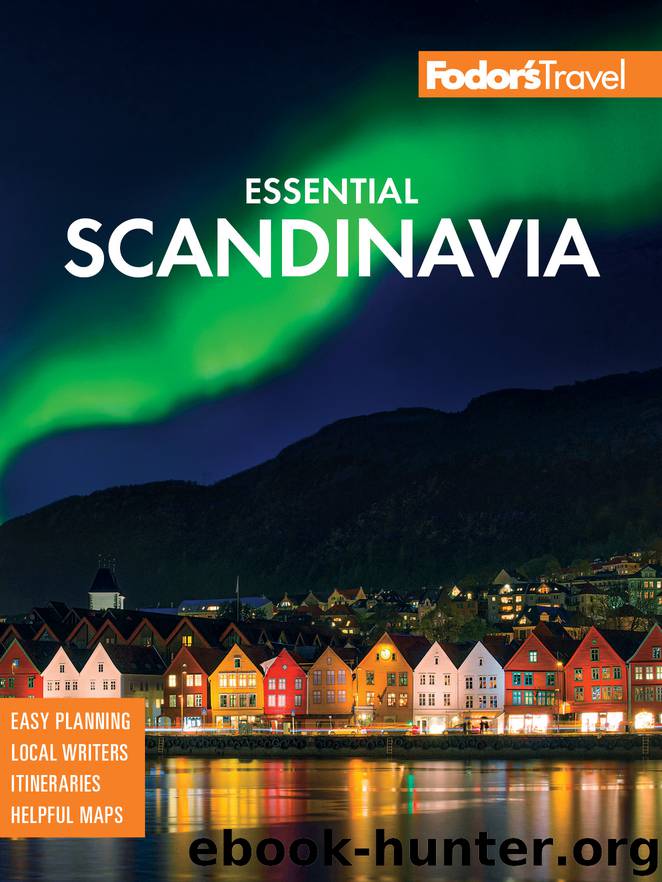Fodor's Essential Scandinavia by Fodor's Travel Guides

Author:Fodor's Travel Guides [Fodor’s Travel Guides]
Language: eng
Format: epub
Publisher: Fodor's Travel
Published: 2020-04-14T00:00:00+00:00
Indre By
Indre By, Copenhagen’s city center and historic heart, surrounds Christiansborg, the hub of Danish government. The neighborhood is packed with shops, restaurants, and businesses, as well as the crowning architectural achievements of King Christian IV. Its boundaries roughly match the fortified borders under his reign (1588–1648), when the city was surrounded by fortified walls and moats. The city center is home to most of Copenhagen’s cultural and historical attractions and its parliament, businesses, and hotels, and many of the city’s most ambitious restaurants and bars are located in the winding lanes between them. The area is residential, and it’s lively all hours of the day and night, especially on weekends.
Indre By is cut by the city’s pedestrian and commercial spine, a 1.8-km (roughly 1-mile) series of streets called Strøget (pronounced stroy-et), Europe’s longest pedestrian shopping strip; the five streets are Frederiksberggade, Nygade, Vimmelskaftet, Amagertorv, and Østergade. Some locals love Strøget, but many love to hate it; the smaller streets surrounding it hold much more charm. By midmorning, particularly on Saturday, it’s congested with people, baby strollers, and motionless-until-paid mimes. To the south and north of Strøget, you will find smaller, more peaceful shopping streets with smaller brands and more personal service.
To the north of Strøget, you will find the smaller, calmer shopping streets of Købmagergade, Fiolstræde, and Nørregade. Kronprinsensgade, off Købmagergade, is another street known for trendy boutiques and cafés. The area spreads from Strøget to the lakes that divide central Copenhagen from the boroughs of Vesterbro, Frederiksberg, Nørrebro, and Østerbro and consists of many mini neighborhoods: the city’s Latin Quarter, called Pisserenden; an area around Nansensgade; and the quieter, posher areas around Kongens Have (King’s Garden). Wherever you go there will be people, bars, and bustling big-city life.
Plan to explore Strøget and its side streets and grand squares on foot. A hurried walk (20 minutes or so) will take you from Kongens Nytorv in the east to City Hall Square and Tivoli, which border Vesterbro in the west. But to fully experience the area, consider spending a few hours or even a full day on shopping, visiting cafés, and taking in notable sights.
Shops along Strøget tend to keep longer hours than those elsewhere. Strøget is good for major stores, posh boutiques, porcelain shops, and street performances. If you prefer unique, nonchain shops, head to the colloquially named Strædet (composed of Kompagnistræde and Læderstræde), one block south, which runs parallel to the main drag from the area just south of City Hall Square to Højbro Plads and Amagertorv. This quieter strip has cafés, design stores, and antiques dealers.
s Sights
Arbejdermuseet (Workers Museum)
MUSEUM | This museum chronicles the working class from 1870 to the present, with evocative life-size “day in the life of” exhibits, among them reconstructions of a city street and re-creations of apartments, including the home of a brewery worker, his wife, and eight children. Changing exhibits focusing on Danish and international social issues are often excellent. The exhibitions have explanatory texts in English. The museum also has a
Download
This site does not store any files on its server. We only index and link to content provided by other sites. Please contact the content providers to delete copyright contents if any and email us, we'll remove relevant links or contents immediately.
Annapurna by Maurice Herzog(3448)
Liar's Poker by Michael Lewis(3413)
A Forest Journey by John Perlin(3043)
Atlas Obscura by Joshua Foer(2931)
The Ogre by Doug Scott(2657)
Cuba by Lonely Planet(2600)
Photographic Guide to the Birds of Indonesia by Strange Morten;(2509)
The Splendid and the Vile by Erik Larson(2415)
Tokyo by Rob Goss(2405)
All Things Reconsidered by Bill Thompson III(2371)
Fatal Storm by Rob Mundle(2194)
A TIME OF GIFTS by Patrick Leigh Fermor(2173)
INTO THE WILD by Jon Krakauer(2170)
DK Eyewitness Top 10 Travel Guides Orlando by DK(2150)
Trail Magic by Trevelyan Quest Edwards & Hazel Edwards(2143)
Touching the Void by Joe Simpson(2107)
Top 10 Dubai and Abu Dhabi by DK Travel(2074)
Abbey in America by Murray John A(2062)
Lonely Planet Australia by Lonely Planet(2052)
